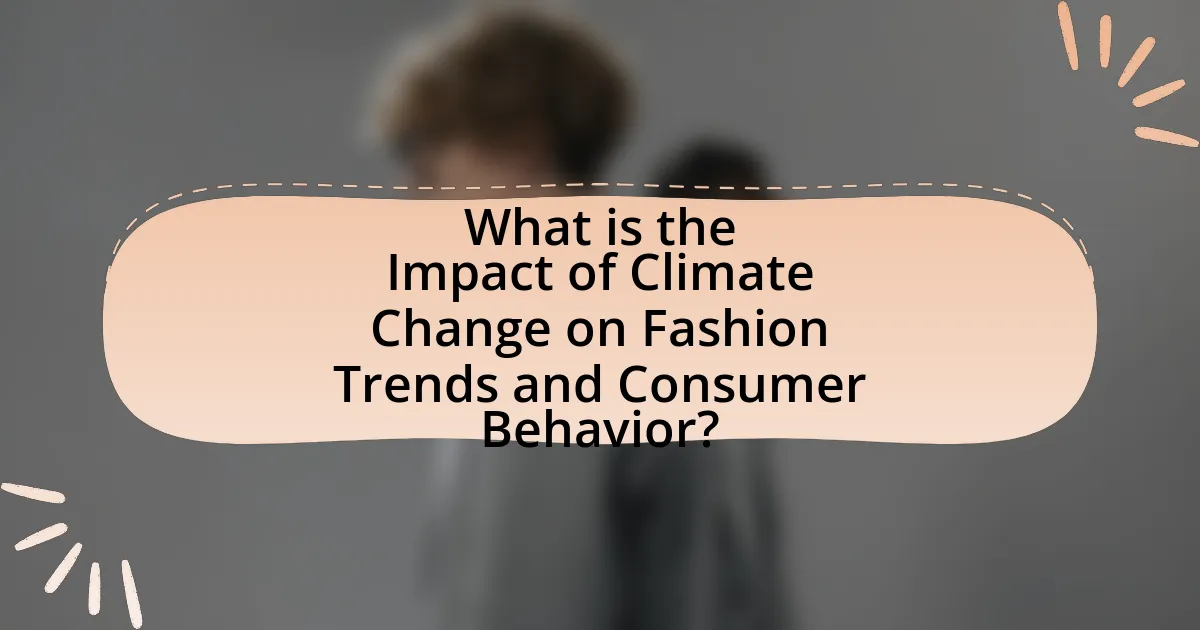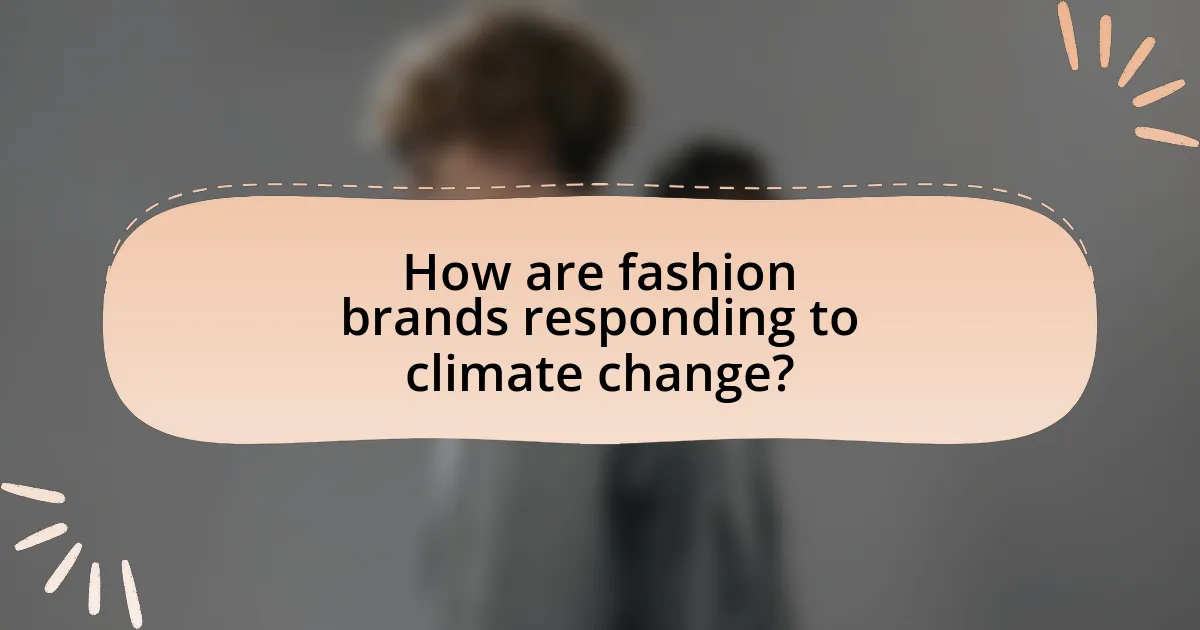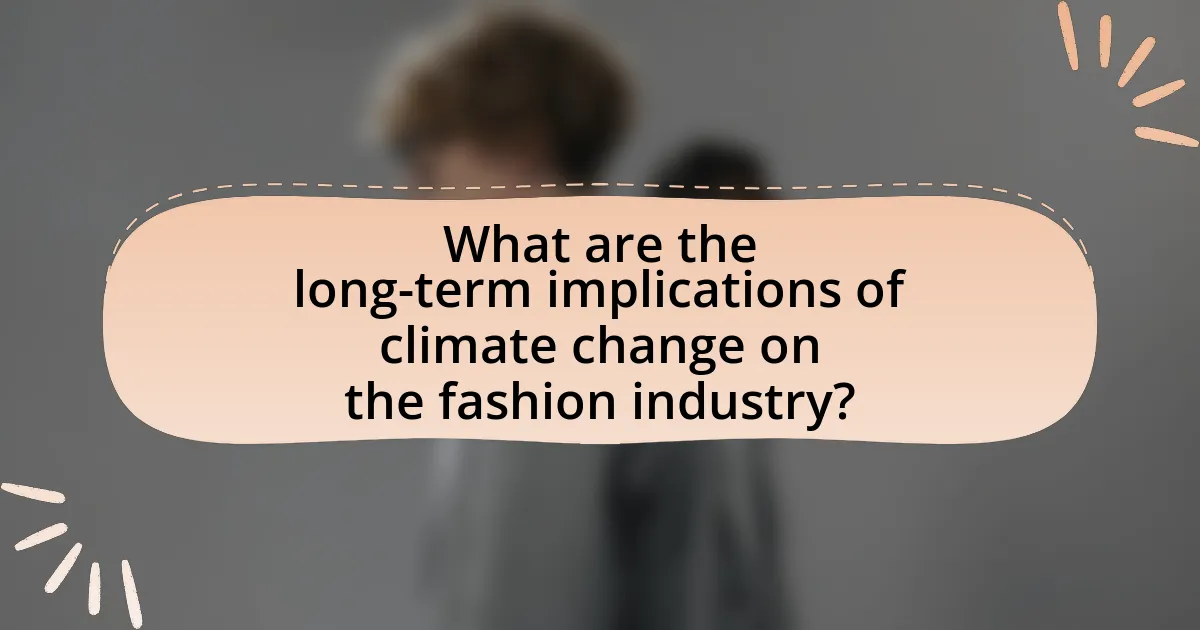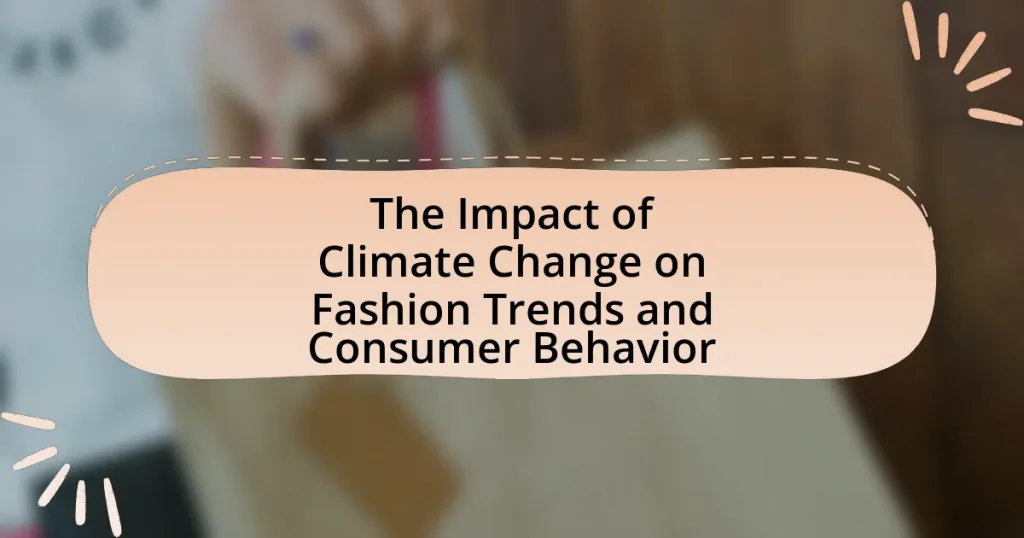The article examines the significant impact of climate change on fashion trends and consumer behavior, highlighting a shift towards sustainability and eco-consciousness. It discusses how increased awareness of environmental issues has led consumers to prefer brands that prioritize sustainable practices, such as using organic materials and reducing waste. Key trends include the rise of circular fashion, where second-hand clothing and clothing swaps are becoming more popular, and the adaptation of designers to create versatile, year-round collections. The article also explores the role of social media and influencers in promoting sustainable fashion choices, the importance of transparency for brands, and the long-term implications of climate change on the fashion industry.

What is the Impact of Climate Change on Fashion Trends and Consumer Behavior?
Climate change significantly influences fashion trends and consumer behavior by driving a shift towards sustainability and eco-consciousness. As awareness of environmental issues grows, consumers increasingly prefer brands that prioritize sustainable practices, such as using organic materials and reducing waste. A study by McKinsey & Company in 2021 found that 67% of consumers consider the use of sustainable materials to be an important factor in their purchasing decisions. Additionally, climate change has led to the rise of circular fashion, where consumers are more inclined to buy second-hand clothing or participate in clothing swaps, reflecting a broader trend towards reducing consumption and promoting longevity in fashion. This shift not only alters what consumers buy but also compels brands to adapt their strategies to meet the demand for environmentally friendly products.
How does climate change influence fashion trends?
Climate change influences fashion trends by driving a shift towards sustainable and eco-friendly materials and practices. As awareness of environmental issues grows, consumers increasingly demand transparency and sustainability from brands, leading to a rise in the popularity of recycled fabrics and ethical production methods. For instance, a 2021 report by McKinsey & Company highlighted that 67% of consumers consider sustainability when making a purchase, indicating a significant market shift. Additionally, extreme weather events and changing climates affect seasonal collections, prompting designers to create versatile, year-round clothing instead of traditional seasonal lines. This adaptation reflects the industry’s response to the realities of climate change, reshaping how fashion is produced and consumed.
What specific fashion trends have emerged due to climate change?
Sustainable fashion has emerged as a significant trend due to climate change, with brands increasingly focusing on eco-friendly materials and ethical production practices. This shift is driven by consumer demand for transparency and sustainability, leading to the rise of upcycled clothing, biodegradable fabrics, and circular fashion models. For instance, a report by McKinsey & Company highlights that 67% of consumers consider sustainability when making a purchase, indicating a clear market trend towards environmentally conscious fashion choices. Additionally, the use of innovative materials such as recycled polyester and organic cotton has gained traction, reflecting a broader industry commitment to reducing carbon footprints and waste.
How do designers adapt their collections in response to climate change?
Designers adapt their collections in response to climate change by incorporating sustainable materials and practices into their design processes. This includes using organic fabrics, recycled materials, and innovative textiles that reduce environmental impact. For instance, brands like Stella McCartney have pioneered the use of vegan leather and sustainable sourcing, demonstrating a commitment to eco-friendly fashion. Additionally, designers are increasingly focusing on creating versatile, long-lasting pieces that encourage consumers to buy less frequently, thereby reducing waste. According to a 2021 report by the Global Fashion Agenda, the fashion industry must reduce its greenhouse gas emissions by 50% by 2030 to align with climate goals, prompting designers to rethink their approaches to production and consumption.
Why is consumer behavior changing in relation to climate change?
Consumer behavior is changing in relation to climate change due to increased awareness of environmental issues and a growing demand for sustainable products. Research indicates that 66% of global consumers are willing to pay more for sustainable brands, reflecting a shift towards eco-conscious purchasing decisions. This change is driven by factors such as heightened media coverage of climate-related events, the influence of social media on consumer values, and the desire for brands to align with personal ethics. Consequently, businesses are adapting their strategies to meet this demand, leading to a significant transformation in the fashion industry and consumer habits.
What factors are driving consumers to prioritize sustainability in fashion?
Consumers are prioritizing sustainability in fashion due to increased awareness of environmental issues, ethical concerns, and the influence of social media. Research indicates that 66% of global consumers are willing to pay more for sustainable brands, reflecting a shift in purchasing behavior driven by a desire to reduce environmental impact. Additionally, the rise of eco-conscious influencers and brands on platforms like Instagram has amplified the visibility of sustainable practices, encouraging consumers to make more informed choices. This combination of awareness, ethical considerations, and social influence is reshaping consumer preferences towards sustainable fashion.
How does awareness of climate change affect purchasing decisions?
Awareness of climate change significantly influences purchasing decisions by increasing consumer preference for sustainable and eco-friendly products. Research indicates that 66% of global consumers are willing to pay more for sustainable brands, reflecting a shift towards environmentally responsible consumption. This trend is driven by heightened awareness of climate issues, leading consumers to prioritize brands that demonstrate commitment to sustainability, such as using recycled materials or reducing carbon footprints. Consequently, businesses that align their practices with these values often experience increased sales and customer loyalty, validating the impact of climate change awareness on consumer behavior.
What role do social media and influencers play in this shift?
Social media and influencers significantly shape consumer behavior regarding climate change and fashion trends by promoting sustainable practices and eco-friendly brands. Influencers leverage their platforms to raise awareness about environmental issues, often showcasing brands that prioritize sustainability, which can lead to increased consumer interest and purchasing decisions aligned with eco-conscious values. For instance, a study by the Global Web Index found that 54% of social media users are influenced by social media when making purchasing decisions, particularly in the fashion sector. This demonstrates the powerful role that social media and influencers play in driving a shift towards more sustainable fashion choices among consumers.
How are influencers promoting sustainable fashion choices?
Influencers are promoting sustainable fashion choices by showcasing eco-friendly brands and advocating for ethical consumption practices. They leverage their platforms to educate followers about the environmental impact of fast fashion, often sharing statistics that highlight the waste generated by the industry, such as the fact that over 92 million tons of textile waste is produced globally each year. Additionally, influencers frequently collaborate with sustainable brands, providing visibility and credibility to these companies, which encourages their audience to consider purchasing from them. This approach not only raises awareness but also drives consumer behavior towards more sustainable options in fashion.
What impact does social media have on consumer awareness of climate issues?
Social media significantly enhances consumer awareness of climate issues by facilitating the rapid dissemination of information and fostering community engagement. Platforms like Twitter, Instagram, and Facebook allow users to share content related to climate change, including news articles, personal stories, and educational resources, which increases visibility and understanding of environmental challenges. Research indicates that social media campaigns, such as the #FridaysForFuture movement initiated by Greta Thunberg, have mobilized millions globally, demonstrating the power of social media in raising awareness and prompting action on climate issues. This engagement not only informs consumers but also influences their purchasing decisions, as they increasingly seek sustainable and eco-friendly products in response to the information shared online.

How are fashion brands responding to climate change?
Fashion brands are responding to climate change by implementing sustainable practices, such as using eco-friendly materials, reducing waste, and adopting circular economy models. For instance, brands like Stella McCartney and Patagonia prioritize organic cotton and recycled polyester in their collections, significantly lowering their carbon footprints. Additionally, the Global Fashion Agenda’s 2021 report highlights that 60% of fashion companies are now committed to reducing greenhouse gas emissions, demonstrating a collective shift towards sustainability. This response is driven by increasing consumer demand for environmentally responsible products, as evidenced by a McKinsey report indicating that 67% of consumers consider sustainability when making fashion purchases.
What strategies are brands implementing to become more sustainable?
Brands are implementing strategies such as adopting circular economy principles, utilizing sustainable materials, and enhancing supply chain transparency to become more sustainable. For instance, many fashion brands are shifting towards using organic cotton, recycled polyester, and biodegradable fabrics, which significantly reduce environmental impact. According to a report by McKinsey & Company, the fashion industry could reduce greenhouse gas emissions by 30% by 2030 through such sustainable practices. Additionally, brands are increasingly investing in technologies that improve energy efficiency and reduce waste during production, further supporting their sustainability goals.
How are brands reducing their carbon footprint in production?
Brands are reducing their carbon footprint in production by implementing sustainable practices such as using renewable energy sources, optimizing supply chains, and adopting circular economy principles. For instance, many brands are transitioning to solar or wind energy to power their manufacturing facilities, which significantly lowers greenhouse gas emissions. Additionally, optimizing supply chains through local sourcing reduces transportation emissions, while circular economy practices, like recycling materials and designing for longevity, minimize waste and resource consumption. According to a report by the Global Fashion Agenda, the fashion industry could reduce its greenhouse gas emissions by 30% by 2030 through these sustainable practices.
What innovations are being introduced to promote eco-friendly materials?
Innovations promoting eco-friendly materials include the development of biodegradable textiles, such as those made from organic cotton and hemp, which reduce environmental impact. Additionally, advancements in recycling technologies enable the transformation of plastic waste into high-quality fibers, exemplified by brands like Parley for the Oceans, which repurpose ocean plastic into apparel. Furthermore, innovations in lab-grown materials, such as mycelium leather, provide sustainable alternatives to traditional animal leather, significantly lowering carbon footprints. These innovations are supported by research indicating that sustainable materials can reduce greenhouse gas emissions by up to 30% compared to conventional materials, highlighting their potential in combating climate change within the fashion industry.
Why is transparency important for brands in the context of climate change?
Transparency is important for brands in the context of climate change because it builds consumer trust and accountability. When brands openly share their environmental practices, such as carbon emissions and sustainable sourcing, they demonstrate commitment to combating climate change. Research indicates that 66% of consumers are willing to pay more for sustainable brands, highlighting the demand for transparency. Furthermore, brands that are transparent can differentiate themselves in a competitive market, as consumers increasingly prefer companies that align with their values regarding environmental responsibility.
How does transparency influence consumer trust and loyalty?
Transparency significantly enhances consumer trust and loyalty by fostering an environment of openness and accountability. When brands openly share information about their practices, sourcing, and sustainability efforts, consumers feel more informed and empowered to make purchasing decisions aligned with their values. Research from the 2021 Global Consumer Insights Survey by PwC indicates that 79% of consumers are more likely to trust a brand that is transparent about its supply chain and environmental impact. This trust translates into increased loyalty, as consumers are more inclined to support brands that demonstrate ethical practices and commitment to sustainability, particularly in the context of climate change.
What are the challenges brands face in maintaining transparency?
Brands face significant challenges in maintaining transparency, primarily due to complex supply chains and varying consumer expectations. The intricate nature of global supply chains makes it difficult for brands to track and disclose the environmental and ethical practices of every supplier. Additionally, consumers increasingly demand detailed information about sourcing, production processes, and sustainability efforts, which can overwhelm brands that lack the necessary data or systems to provide such transparency. According to a 2021 survey by McKinsey, 67% of consumers consider sustainability and transparency important when making purchasing decisions, highlighting the pressure on brands to meet these expectations while navigating their operational complexities.
How are collaborations shaping the future of sustainable fashion?
Collaborations are significantly shaping the future of sustainable fashion by fostering innovation and resource sharing among brands, designers, and organizations. These partnerships enable the pooling of expertise and sustainable practices, leading to the development of eco-friendly materials and production methods. For instance, collaborations like the one between Adidas and Parley for the Oceans have resulted in the creation of footwear made from recycled ocean plastic, demonstrating a tangible impact on reducing waste. Furthermore, joint initiatives often amplify consumer awareness and engagement regarding sustainability, as seen in campaigns that highlight the environmental benefits of collaborative products. This collective approach not only enhances brand credibility but also drives industry-wide shifts towards more sustainable practices, ultimately influencing consumer behavior and preferences in favor of environmentally responsible fashion choices.
What partnerships are emerging between brands and environmental organizations?
Emerging partnerships between brands and environmental organizations focus on sustainability initiatives and eco-friendly practices. For instance, brands like Patagonia collaborate with organizations such as 1% for the Planet, committing a portion of their sales to environmental causes. Additionally, H&M has partnered with the Ellen MacArthur Foundation to promote circular fashion, aiming to reduce waste through recycling and sustainable sourcing. These collaborations reflect a growing trend where brands align their business models with environmental goals, responding to consumer demand for responsible practices.
How do collaborations enhance brand credibility in sustainability?
Collaborations enhance brand credibility in sustainability by leveraging the expertise and reputation of multiple organizations to create a unified message and impact. When brands partner with established sustainability leaders or NGOs, they gain access to proven practices and resources that validate their commitment to environmental responsibility. For instance, a study by Nielsen found that 66% of consumers are willing to pay more for sustainable brands, indicating that partnerships with credible organizations can significantly influence consumer perception and trust. This collaborative approach not only amplifies the reach of sustainability initiatives but also fosters transparency and accountability, essential factors in building long-term credibility in the eyes of consumers.

What are the long-term implications of climate change on the fashion industry?
The long-term implications of climate change on the fashion industry include increased resource scarcity, shifts in consumer behavior, and heightened regulatory pressures. As climate change progresses, the availability of raw materials such as cotton and wool is expected to decline due to extreme weather events and changing agricultural conditions. This scarcity can lead to higher production costs and a shift towards sustainable materials. Additionally, consumers are increasingly prioritizing sustainability, driving brands to adopt eco-friendly practices and transparency in their supply chains. Regulatory frameworks are also tightening, compelling the fashion industry to comply with stricter environmental standards. These factors collectively reshape the industry’s landscape, pushing it towards more sustainable practices and altering consumer preferences.
How might climate change reshape the future of fashion consumption?
Climate change is likely to reshape the future of fashion consumption by driving a shift towards sustainable practices and materials. As consumers become increasingly aware of the environmental impact of fast fashion, demand for eco-friendly products is expected to rise. According to a 2021 McKinsey report, 67% of consumers consider sustainability when making a purchase, indicating a significant trend towards responsible consumption. This shift will likely lead brands to adopt circular economy models, prioritize transparency in supply chains, and invest in innovative materials that reduce carbon footprints.
What trends are expected to dominate the fashion industry in the coming years?
Sustainability and eco-friendly practices are expected to dominate the fashion industry in the coming years. As consumers increasingly prioritize environmental responsibility, brands are adopting sustainable materials, such as organic cotton and recycled fabrics, to reduce their carbon footprint. According to a McKinsey report, 67% of consumers consider sustainability when making a purchase, indicating a significant shift towards eco-conscious buying behavior. Additionally, the rise of circular fashion, which emphasizes recycling and upcycling, is gaining traction as brands seek to minimize waste and promote longevity in clothing. This trend aligns with the growing awareness of climate change and its impact on consumer choices, driving the fashion industry towards more sustainable practices.
How will consumer expectations evolve regarding sustainability?
Consumer expectations regarding sustainability will increasingly demand transparency and accountability from brands. As awareness of climate change and environmental issues grows, consumers are prioritizing sustainable practices, such as ethical sourcing, reduced carbon footprints, and waste management. A 2021 survey by McKinsey found that 67% of consumers consider sustainability when making purchasing decisions, indicating a significant shift towards eco-conscious consumption. This trend is expected to intensify, with consumers likely to favor brands that demonstrate genuine commitment to sustainability over those that engage in greenwashing.
What are the potential economic impacts on the fashion industry?
The potential economic impacts on the fashion industry include increased production costs, shifts in consumer demand, and changes in supply chain dynamics. Climate change leads to resource scarcity, such as water shortages and raw material availability, which raises production costs for manufacturers. Additionally, consumers are increasingly favoring sustainable and eco-friendly brands, prompting a shift in demand that can affect sales for traditional fashion companies. According to a report by McKinsey & Company, the global fashion industry could lose up to $65 billion annually by 2030 if it fails to adapt to climate-related challenges. These factors collectively influence profitability and market positioning within the fashion sector.
How could climate change affect the pricing of fashion items?
Climate change could significantly increase the pricing of fashion items due to disruptions in supply chains and raw material availability. As extreme weather events become more frequent, agricultural production of natural fibers like cotton and wool may decline, leading to scarcity and higher costs. For instance, a report from the United Nations indicates that climate change could reduce global crop yields by up to 30% by 2050, directly impacting the cost of materials used in fashion. Additionally, increased regulatory measures aimed at reducing carbon emissions may impose additional costs on manufacturers, further driving up retail prices.
What risks do brands face if they fail to adapt to climate change?
Brands face significant risks if they fail to adapt to climate change, including reputational damage, financial losses, and regulatory penalties. Reputational damage occurs as consumers increasingly favor environmentally responsible brands; a 2021 survey by McKinsey found that 67% of consumers consider sustainability when making purchasing decisions. Financial losses can arise from supply chain disruptions caused by extreme weather events, which have been shown to impact production and distribution, leading to decreased sales. Additionally, regulatory penalties are becoming more common as governments implement stricter environmental regulations; for instance, the European Union’s Green Deal aims to make Europe climate-neutral by 2050, imposing compliance costs on non-adaptive brands.
What practical steps can consumers take to support sustainable fashion?
Consumers can support sustainable fashion by choosing to buy from brands that prioritize ethical production practices and use eco-friendly materials. Research indicates that the fashion industry is responsible for 10% of global carbon emissions, highlighting the importance of conscious consumer choices. By selecting clothing made from organic cotton, recycled materials, or sustainable fabrics, consumers can reduce their environmental impact. Additionally, supporting second-hand shopping and clothing swaps can extend the lifecycle of garments, further minimizing waste. Engaging in these practices not only promotes sustainability but also encourages brands to adopt more responsible methods in response to consumer demand.
How can consumers make informed choices when shopping for clothing?
Consumers can make informed choices when shopping for clothing by researching brands’ sustainability practices and understanding the environmental impact of their purchases. This involves checking for certifications like Fair Trade or Global Organic Textile Standard, which indicate ethical production methods. Additionally, consumers should consider the materials used in clothing, as natural fibers like organic cotton have a lower environmental footprint compared to synthetic materials. According to a 2021 report by the Ellen MacArthur Foundation, the fashion industry is responsible for 10% of global carbon emissions, highlighting the importance of making eco-conscious choices. By prioritizing sustainable brands and materials, consumers can significantly reduce their impact on climate change while shopping for clothing.
What are some tips for building a sustainable wardrobe?
To build a sustainable wardrobe, prioritize quality over quantity by selecting durable, timeless pieces that reduce the need for frequent replacements. This approach is supported by the fact that the fashion industry is responsible for 10% of global carbon emissions, highlighting the importance of mindful consumption. Additionally, choose clothing made from eco-friendly materials such as organic cotton, Tencel, or recycled fabrics, as these options have a lower environmental impact compared to conventional materials. Incorporating second-hand or vintage clothing into your wardrobe also contributes to sustainability by extending the lifecycle of garments and reducing waste. Lastly, support brands that prioritize ethical practices and transparency in their supply chains, as this encourages more sustainable production methods across the industry.




